Stories of Ruler Portraits
Since (ugh) election time coming around once again, let’s look at some interesting portraits of people who were never elected (except for the last one). There are always interesting tidbits about these sovereigns from the past. POP QUIZ: What do the first and last guys have in common? (answer at end)
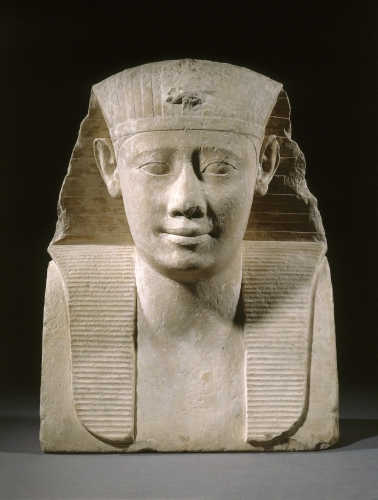 |
| Ancient Egypt, Ptolemy II (309–246 BCE), between 285 and 246 BCE. Limestone, from Benha il-Assel, 17 15/16" x 13 15/16" x 8 1/4" (45.5 x 35.5 x 21 cm). © Brooklyn Museum. (BMA-4903) |
Ptolemy II was the son of the dynasty’s founder, Ptolemy Soter (ca. 367–ca. 283 BCE). Aside from the questionable success of military endeavors to expand Greek Egypt’s power in the eastern Mediterranean, he was a good diplomat and established a strong relationship with Egyptians, as well as a thriving economy, allowing Egypt autonomy from Greece. He actively encouraged the Egyptian religion and artistic conventions, while also following those of the Greeks. While Egyptian pharaohs had always been considered gods themselves, he established the cult of the “brother god,” a practice that would have profound influence on the cult of the emperor in the Roman Empire.
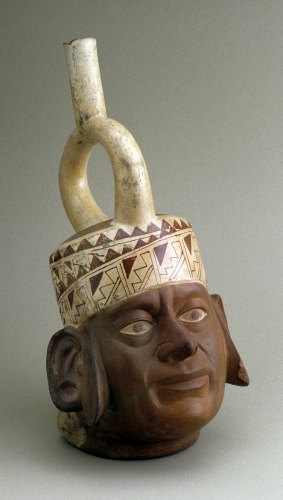 |
| Ancient Peru, Moche Culture, Portrait Head Vessel, 400–600 CE. Earthenware, 13" x 8 1/4" x 7" (33 x 21 x 18 cm). © Museum of Fine Arts, Houston. (MFH-628) |
The Moche culture flourished between 100 BCE and 750 CE on a narrow desert plain between the Pacific and the Andes mountains in northern Peru. The culture is probably most famous for the effigy vessels found in the tombs of the ruling class. The Moche had a stratified society in which the rulers also acted as religious leaders. Like many Mesoamerican and South American cultures, the Moche cities were dominated by central palace/civic worship complexes from which governmental and religious activities were overseen. It is tempting to look at these effigy vessels as portraits of the deceased, but their purpose and inspiration are unknown. The elaborate headdress of this male becomes what is known as a “stirrup” handle.
 |
| Attributed to Yan Liben (ca. 600–673 CE, China), Emperor Wu of Jin (236–290 CE) and Emperor Zhaoli of Shu (162–223 CE), section of the handscroll The Thirteen Emperors. Ink and color on silk, height: 20 3/16" (51.3 cm"), overall length: 17' 42" (531 cm). © MFA, Boston. (MFAB-646B) |
These figures come from the famous Thirteen Emperors handscroll. It was painted during the Tang Dynasty (618–907 CE), an early renaissance of Chinese culture. The long period of domination of northern China by foreigners that engendered the Six Dynasties Period (220–589 CE), led to a yearning by the Chinese to reunite the country and reestablish the glorious culture that had flourished during the Han Dynasty (206 BCE–220 CE). The short-lived Sui dynasty (589–618 CE) failed to do what the Tang dynasty succeeded in doing in the early 600s. The founder of the Tang dynasty, who had much northern blood, successfully managed to control the "barbarian" cultures in the north and west. This reopened the trade routes to the west, and left China once again open to an abundance of artistic wealth and innovation. This scroll depicts illustrious emperors of the Six Dynasties and Han periods.
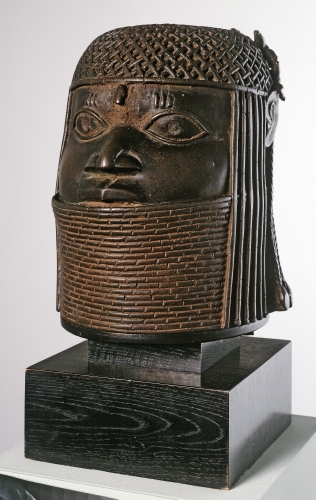 |
| Edo People, Nigeria, Head of an Oba, 1575–1650. Bronze, 9 3/4" x 7 1/2" x 7 3/4" (24.76 x 19.05 x 19.68 cm). © Albright-Knox Art Gallery, Buffalo, NY. (AK-36) |
The Edo culture of Nigeria created one of the many fabulous kingdoms of pre-colonial Africa. The Benin Kingdom began to flourish during the late 1400s and lasted until stamped out by the British in the 1800s. They excelled in lost-wax cast metal sculpture of bronze and brass. The Benin Kingdom was a monarchy in which the oba (king) ruled over subsidiary regional chiefs/vassals. After the death of the oba/king, the successor was expected to honor the deceased with the creation of a commemorative head. Heads such as this were placed upon an altar in the palace. Not only did they commemorate the past leader, but they acted as a constant guiding presence of the deceased oba. In Edo culture, the head was considered the center of a person's intelligence, wisdom, authority, and family leadership. One of the honorific names for the oba is "Great Head."
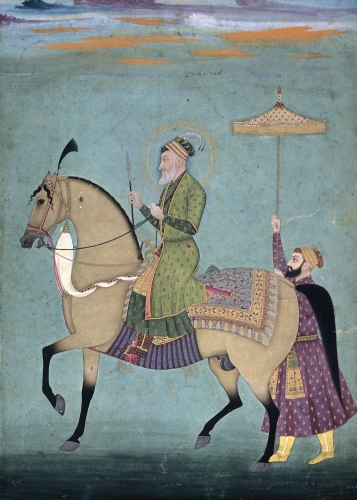 |
| India, Mughal Dynasty, The Emperor Aurangzeb (1618–1707) on Horseback, 1690–1710. Ink and color on paper, 12" x 8 3/4" (30.5 x 22.3 cm). © Cleveland Museum of Art. (CL-128) |
In 1526 the Turk/Mongol leader Babur (1483–1530) founded the Mughal Empire when he invaded and conquered northern India (including present-day Pakistan). Under Babur’s successors, especially the emperor Akbar (1542–1607), the empire grew to encompass three-quarters of the Indian subcontinent. The Mughal emperors tolerated the other major faiths of India, such as Hinduism, Buddhism, and Sikh. The exception was Aurangzeb (1618–1707), who tried to abolish the Sikh sect. Aurangzeb (died 1707), a conservative Muslim, disapproved of music and art, and as a result the arts declined during his reign. This is likely a posthumous portrayal of the emperor. Halos such as this were not only meant to signify sainted figures of Islam, but also revered rulers.
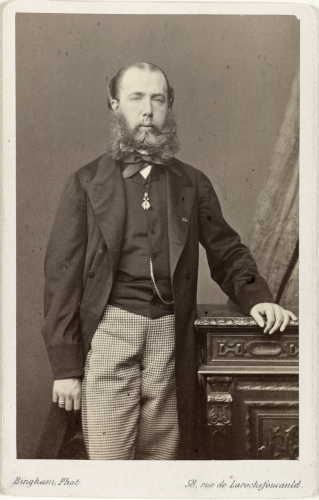 |
| Robert J. Bingham (1824–1910, Britain), Maximilian (1832–1867), Emperor of Mexico, 1864–1867. Albumen silver print on paper mounted on cardstock, 3 1/2" x 2 1/4" (9 x 5.7 cm). © The Museum of Modern Art, New York. (MOMA-P3439) |
This poor slob with the deer-in-the-headlights look—the brother of the emperor of the Austro-Hungarian Empire—was prevailed upon by the French in 1863 to become emperor of Mexico, creating a French foothold in the Western Hemisphere. The French invaded Mexico in 1862 in order to force the country to repay its debts to France. Napoleon III (1808–1873), the French ruler, wanted a European ruling Mexico to establish stability after the turmoil of civil war there (after 1855). Maximilian tried unsuccessfully to bring the opposing factions to agreement, angering conservatives with some liberal reforms. After the French withdrew their troops in 1865, Maximilian’s regime quickly collapsed under liberal forces led by reformer Benito Juarez (died 1872). He was captured and executed in 1867.
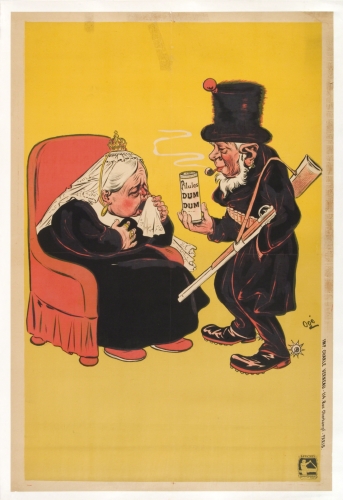 |
| Ogé (1861–1936, France), President Kruger of Transvaal Offering Pills to Queen Victoria – Pills Dum Dum, 1900. Color metal relief print on paper, 43 9/16" x 29 1/2" (110.8 x 74.9 cm). © Philadelphia Museum of Art. (PMA-3930) |
Throughout history, the French have always enjoyed seeing the British have troubles, and vice versa. So, it is not surprising that a French artist drew this cartoon of Britain’s Queen Victoria (1819–1901) during the stupid Second Boer War (1899–1902). That was basically a war fought between Britain and the Dutch colonists for land and control of all of southern Africa, and the rich gold mining industry. The result of the war was the formation of the Union of South Africa. This cartoon shows the Boer president Paul Kruger offering a sick Queen Victoria Dum Dum pills, a remedy for colds. “Dum dum” was also slang for bullets, hence the rifle he’s carrying.
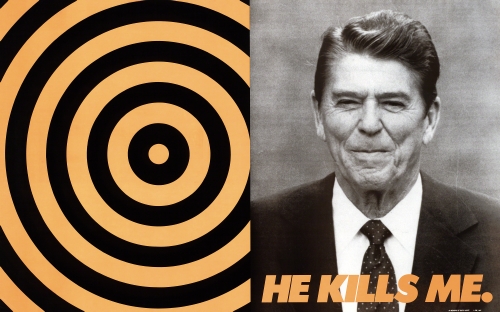 |
| Donald Moffett (born 1955, US), He Kills Me, 1987. Color offset lithograph on paper, 23 3/8" x 37 3/8" (59.5 x 95 cm). The Museum of Modern Art, New York. © 2015 Donald Moffett. (MOMA-P3073) |
Answer to POP QUIZ: Ptolemy and Reagan are both deified rulers!
Ronald Reagan’s (1911–2004) presidency launched the “Reagan Revolution,” which was basically an anti-big-government movement that has affected American politics to the present day. His presidency was also known for the period that witnessed the collapse of Communism as a viable governmental form in Russia and Eastern Europe, in part because of Reagan’s peace-through-strength stance that led ultimately to better relations with Russia and the end of the Cold War. This artist parodies one of the low points of Reagan’s administration when he unintentionally told a stupid joke over the air before his weekly radio broadcast in 1984 claiming that he had outlawed Russia forever and would start “bombing in five minutes.” Some politicians today still hark back to the “Reagan Revolution” as if it were a religion.


Comments